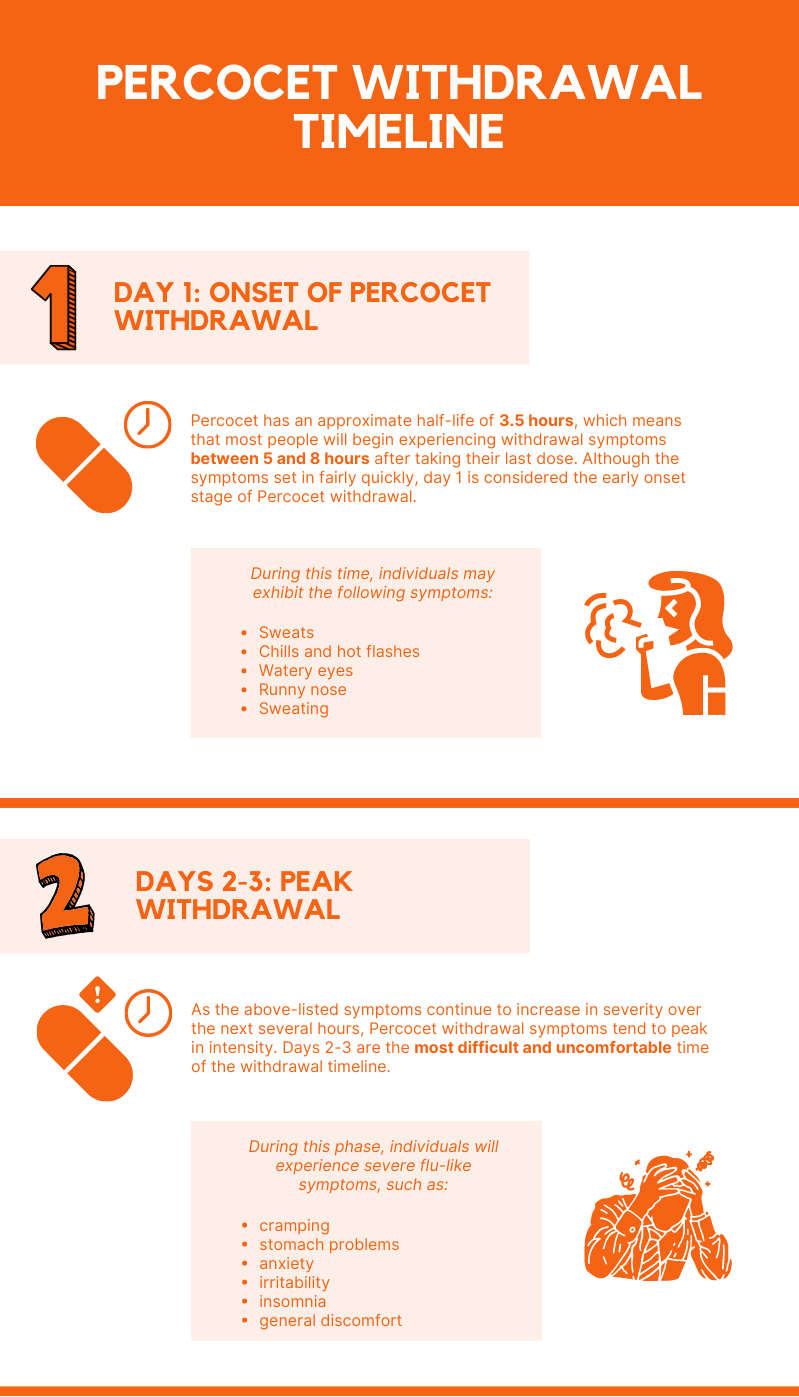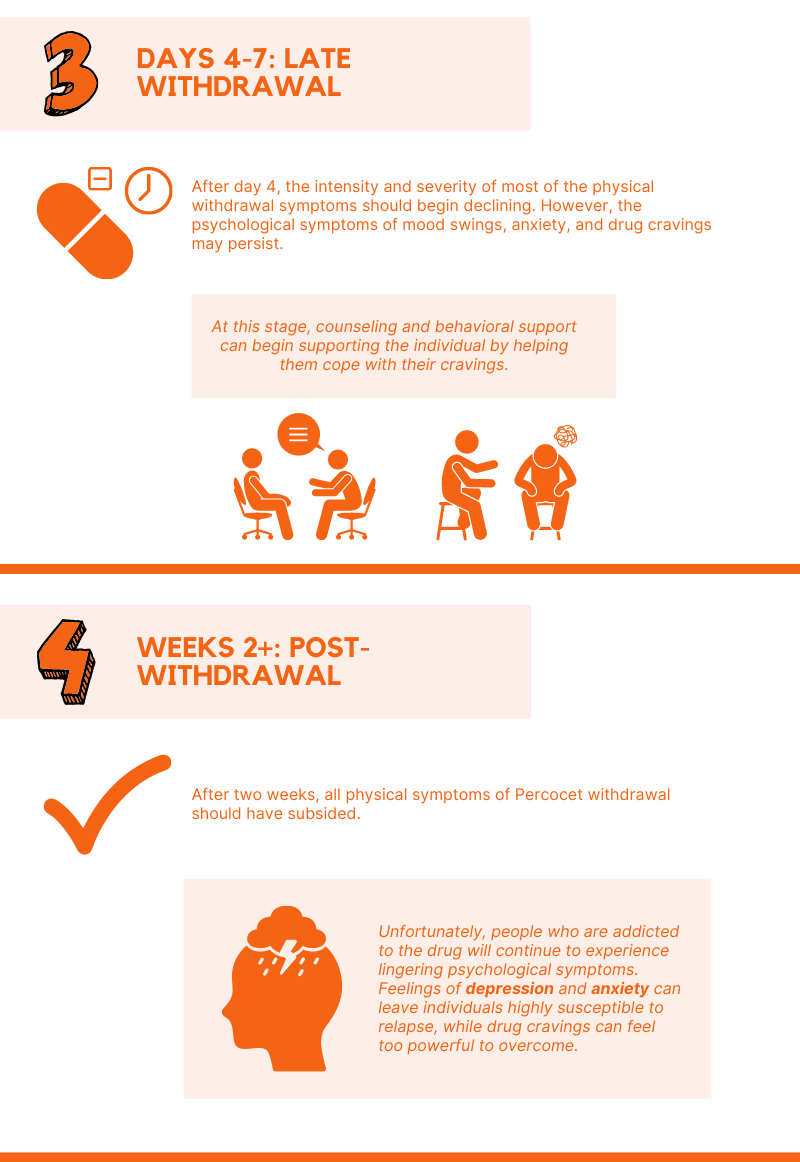Between 21-29% of people who are prescribed opioids for chronic pain end up abusing them. Moreover, even more people who purchase these drugs on the street become addicted to them. Unfortunately, due to the highly addictive nature of opioids, they are some of the most popular and most deadly drugs of misuse in the nation – with Percocet being one of the most widely known.[1]
Percocet is a prescription opioid that is used to manage pain. Regular abuse of the drug can cause dependence or addiction, making it difficult to quit without professional help. Stopping Percocet use is associated with intense withdrawal symptoms and challenging drug cravings that can last for several days, a week, or more. Whether you or a loved one is using Percocet, here is everything you need to know about the Percocet withdrawal timeline.
What is Percocet?
Percocet is a narcotic prescription painkiller that contains both oxycodone and acetaminophen. Acetaminophen, the generic name for Tylenol, is an over-the-counter medication used to treat mild to moderate pain or to reduce fevers. Oxycodone, on the other hand, is a potent opioid used to treat moderate to severe pain and change the way the brain perceives pain. The two drugs work together to alter the way the body feels and responds to pain sensations. Similar to other prescription opiates, Percocet carries a high potential for abuse and the development of a substance use disorder. As a result, the medication is classified by the United States Drug Enforcement Administration (DEA) as a schedule II substance. This means that although Percocet has valuable medical use, it is also dangerous when abused.[2]
Percocet Abuse and Addiction
Some people may abuse Percocet pills by crushing and snorting them, injecting them in the form of a liquid solution, or swallowing them. Any use of the medication that does not follow the instructions on the bottle or as instructed by a doctor is considered abuse. When someone is abusing opiates such as Percocet, they may experience the following side effects:
- Drowsiness
- Constricted pupils
- Nausea
- Itchiness
- Confusion
- Constipation
- Slowed breathing
- Kidney failure
- Liver damage
After long-term drug abuse, the mind and body become dependent on opioids. When this occurs, it’s likely that a person is addicted and will experience withdrawal symptoms when they try to cut back on the amount that they use or try to stop altogether. Typically, the Percocet withdrawal timeline sets in just hours after a person’s last dose. Unfortunately, the psychological and physical discomfort that is caused by withdrawal makes it extremely difficult for individuals to stop taking Percocet without professional help.
Symptoms of Percocet Withdrawal
Withdrawal symptoms are triggered by the sudden removal of a substance that the brain and body are dependent on. Although opiate withdrawal is generally not life-threatening, the symptoms are extremely uncomfortable and mirror a severe case of the flu. Symptoms you can expect to see throughout the timeline of Percocet withdrawal include:[3]
- Watery eyes
- Runny nose
- Muscle pain
- Weakness
- Anxiety
- Restlessness
- Excessive yawning
- Sleep disturbances
- Insomnia
- Sweating
- Goosebumps
- Diarrhea
- Nausea
- Vomiting
- Abdominal cramps
- Dilated pupils
- Rapid heartbeat
- High blood pressure
Additionally, people who are addicted to Percocet may experience memory problems, difficulty concentrating, intense mood swings, and strong drug cravings. The combination of these psychological symptoms is perhaps even more difficult than the physical ones, as these often drive individuals back to their drug of choice.
Percocet Withdrawal Timeline
The symptoms users experiences during Percocet withdrawal will vary in severity and duration depending on the length and dosage of their drug use. For example, the following factors influence the duration of the Percocet withdrawal timeline:
- How often a person takes the drug
- The dosage the person is used to taking
- Age
- Weight
- Mental health
- Family history
- Medical history
- Polydrug use
- Past experiences with opiate withdrawal
Furthermore, people should never stop taking Percocet cold turkey. Instead, the most effective way to manage withdrawal symptoms is to work with a team of medical professionals who can detox individuals properly. By either tapering the dose down gradually or replacing Percocet with a less potent opioid, the symptoms of withdrawal can be largely reduced.
Day 1: Onset of Percocet Withdrawal
Percocet has an approximate half-life of 3.5 hours, which means that most people will begin experiencing withdrawal symptoms between 5 and 8 hours after taking their last dose. Although the symptoms set in fairly quickly, day 1 is considered the early onset stage of Percocet withdrawal. During this time, individuals may exhibit the following symptoms:
- Sweats
- Chills and hot flashes
- Watery eyes
- Runny nose
- Sweating
Days 2-3: Peak Withdrawal
As the above-listed symptoms continue to increase in severity over the next several hours, Percocet withdrawal symptoms tend to peak in intensity. Days 2-3 are the most difficult and uncomfortable time of the withdrawal timeline. During this phase, individuals will experience severe flu-like symptoms, such as cramping, stomach problems, anxiety, irritability, insomnia, and general discomfort.
Days 4-7: Late Withdrawal
After day 4, the intensity and severity of most of the physical withdrawal symptoms should begin declining. However, the psychological symptoms of mood swings, anxiety, and drug cravings may persist. At this stage, counseling and behavioral support can begin supporting the individual by helping them cope with their cravings.
Weeks 2+: Post-Withdrawal
After two weeks, all physical symptoms of Percocet withdrawal should have subsided. Unfortunately, people who are addicted to the drug will continue to experience lingering psychological symptoms. Feelings of depression and anxiety can leave individuals highly susceptible to relapse, while drug cravings can feel too powerful to overcome. As a result, even though the detox process is over, the risk of relapse is still high two weeks after the beginning of withdrawal. This is why behavioral therapy and counseling are at the foundation of rehabilitation programs.


Treatment Options for Opiate Addiction
Addiction to pain relievers is a condition that requires professional treatment. In most cases, experts recommend that people who are detoxing from opiates do so in a medical facility or drug detox center that provides around-the-clock support. Various medications, including Suboxone(buprenorphine/naltrexone), methadone, and clonidine, may be administered to help minimize drug cravings and relieve your withdrawal symptoms. Similarly, medications like benzodiazepines or SSRIs may be prescribed to treat anxiety or depression while over-the-counter medications can be given for nausea, vomiting, or diarrhea.[4] Regardless of the severity of your symptoms, the purpose of medication-assisted detox is to ensure your safety and comfort throughout the withdrawal process.
Get Help Throughout the Percocet Withdrawal Timeline and Beyond
After detox, your body is clear from drugs and alcohol, but there is still a long road of recovery ahead. Since Percocet addiction affects the way the brain perceives reward and pain, your mind needs time to heal from the effects of substance abuse. Once you’ve successfully endured the Percocet withdrawal timeline, your next step will be participating in an evidence-based addiction treatment program.
When you choose PAX Memphis Recovery Center as your drug rehab center, we’ll be with you every step of the way. From helping you manage your withdrawal symptoms during medical detox to creating a unique treatment and aftercare plan that meets your needs, you will know that you’re receiving the best possible care.
If you or a loved one needs detox and treatment for Percocet addiction, don’t wait any longer. Our Percocet detox and rehab program in Memphis, TN will keep you safe, comfortable, and supported throughout your entire journey with us. Call us today to get started.
References:
Medically Reviewed: September 25, 2019

All of the information on this page has been reviewed and verified by a certified addiction professional.










